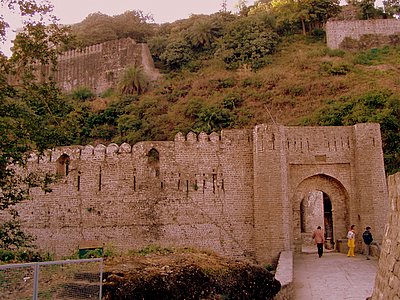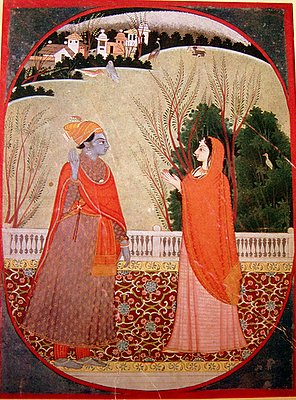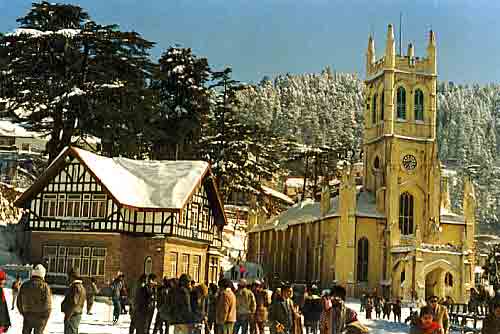 Kangra,
the land of ancient Trigarta, occupying the lower valley of the
fleas and its tributaries, was in ancient times, one of the leading
hill states of Punjab and it was a part of the Kingdom of Jalandhara.
When the plains of Punjab were subjugated by the Muslims, the Kings
of that principality withdrew to their territories in the hills,
retained in the Kangra Fort a strong hold of which more than once
thwarted the attempts of the Muslim invaders. The Fort, also known
as the Nagarkot or Kot Kangra, is situated to the south-west of the
old Kangra town (lat 32°, 5' Long 76°,15') and built on the top of
the precipitious hill on the confluence of the Banganga and Manjhi
or Patal Ganga rivers which also serve as the most of the Fort.
Access to the Fort from the town at this place where the ridge of
rock which separates the two rivers is narrowed to a mere neck of
about 50 m across which a deep ditch has been hewn at the foot of
the walls. The antiquity of the Fort is traced back to a much
earlier period. The earliest extant remains inside the Fort are the
Jaina and Brahmanical temples which could be dated to around the
ninth-tenth century AD. In the annals of history, its first
reference occurs at the time of invasions of Mahmud Ghazni in AD
1009. In 1337 AD it was captured by Muhammad Tughlaq and again in
1351 by his successor Firoz Shah. But it did not fall to the Muslims
permanently until 1621, when after a siege of fourteen months it was
conquered by Jahangir, who garrisoned it with his troops and
appointed a Mughal Governor to keep the hill chief in the check. The
surrounding states however, remained in the hands of the Katoch
Rajas. In the second half of the eighteenth century, after the death
of its Governor Nawab Alif Khan, the Mughal power rapidly declined
and Raja Sansar Chand II succeeded in 1786 in recovering the ancient
fortress of his ancestors. But by carrying his ambitious design he
came into conflict first with the neighbouring hill chiefs then with
the Gurkhas of Nepal, under Amar Singh Thapa and finally with the
Sikh ruler Maharaja Ranjit Singh to whom he was compelled to
surrender the Fort in 1809. It remained in the hands of the Sikhs
till 1846 when it was made over to the British Government along with
the hill States as far as Ravi. The Fort continued to be held by a
garrison but was evacuated sometime before the great earthquake on
4th April 1905 in which extensive damage was sustained. Kangra,
the land of ancient Trigarta, occupying the lower valley of the
fleas and its tributaries, was in ancient times, one of the leading
hill states of Punjab and it was a part of the Kingdom of Jalandhara.
When the plains of Punjab were subjugated by the Muslims, the Kings
of that principality withdrew to their territories in the hills,
retained in the Kangra Fort a strong hold of which more than once
thwarted the attempts of the Muslim invaders. The Fort, also known
as the Nagarkot or Kot Kangra, is situated to the south-west of the
old Kangra town (lat 32°, 5' Long 76°,15') and built on the top of
the precipitious hill on the confluence of the Banganga and Manjhi
or Patal Ganga rivers which also serve as the most of the Fort.
Access to the Fort from the town at this place where the ridge of
rock which separates the two rivers is narrowed to a mere neck of
about 50 m across which a deep ditch has been hewn at the foot of
the walls. The antiquity of the Fort is traced back to a much
earlier period. The earliest extant remains inside the Fort are the
Jaina and Brahmanical temples which could be dated to around the
ninth-tenth century AD. In the annals of history, its first
reference occurs at the time of invasions of Mahmud Ghazni in AD
1009. In 1337 AD it was captured by Muhammad Tughlaq and again in
1351 by his successor Firoz Shah. But it did not fall to the Muslims
permanently until 1621, when after a siege of fourteen months it was
conquered by Jahangir, who garrisoned it with his troops and
appointed a Mughal Governor to keep the hill chief in the check. The
surrounding states however, remained in the hands of the Katoch
Rajas. In the second half of the eighteenth century, after the death
of its Governor Nawab Alif Khan, the Mughal power rapidly declined
and Raja Sansar Chand II succeeded in 1786 in recovering the ancient
fortress of his ancestors. But by carrying his ambitious design he
came into conflict first with the neighbouring hill chiefs then with
the Gurkhas of Nepal, under Amar Singh Thapa and finally with the
Sikh ruler Maharaja Ranjit Singh to whom he was compelled to
surrender the Fort in 1809. It remained in the hands of the Sikhs
till 1846 when it was made over to the British Government along with
the hill States as far as Ravi. The Fort continued to be held by a
garrison but was evacuated sometime before the great earthquake on
4th April 1905 in which extensive damage was sustained.
The Fort, occupying a long strip of land is enclosed with high
rampart and the walls cover a circuit of about four kilometres. The
main entrance gate is called the Ranjit Singh Gate which is followed
by a narrow path leading to Jahangir gate, through the Ahani and
Amiri Darwaza, both attributed to Nawab Alif Khan, the first Mughal
Governor of Kangra. Thereafter is the Andheri Darwaza from where the
path is forked into two directions. The path to the left, through
Darsani Darwaza, leads to the portion containing the Laxminarayan
temple, datable to Circa ninth-tenth century AD and shrines of
Sitala and Ambika Devi. To the north between the two last mentioned
buildings is a staircase led up to the palace, known as Shish Mahal
and further beyond to the south-west is the polygonal watch tower
overlooking the valley. The other path leads to the portion
containing the mihrab of a mosque built in Jahangir's time, the
Kapoor Sagar tank and other structures.
The Fort, occupying a long strip of land is enclosed with high
rampart and the walls cover a circuit of about four kilometres. The
main entrance gate is called the Ranjit Singh Gate which is followed
by a narrow path leading to Jahangir gate, through the Ahani and
Amiri Darwaza, both attributed to Nawab Alif Khan, the first Mughal
Governor of Kangra. Thereafter is the Andheri Darwaza from where the
path is forked into two directions. The path to the left, through
Darsani Darwaza, leads to the portion containing the Laxminarayan
temple, datable to Circa ninth-tenth century AD and shrines of
Sitala and Ambika Devi. To the north between the two last mentioned
buildings is a staircase led up to the palace, known as Shish Mahal
and further beyond to the south-west is the polygonal watch tower
overlooking the valley. The other path leads to the portion
containing the mihrab of a mosque built in Jahangir's time, the
Kapoor Sagar tank and other structures.
The most valuable monuments in the Kangra Fort are the so-called
temples of Laxminarayan and Sitala, two square chambers profusely
decorated with carvings. The ceilings of the Laxminarayan temple is
remarkable for its elaborate decoration: The destruction of these
two temples is due to earthquake and is perhaps great loss of an
irreparable nature. The temple of Ambika Devi, still used for
worship is much plainer structure evidently of no great age. The
only ancient portion seams to be the pillars and architraves of the
mandapa
 covered
by a flat dome. To the south of the Ambika Devi temple are two small
Jaina shrines facing west, one of them contains a plain pedestal and
in the other is placed a seated image of Adinath, with partly
obliterated inscription dated Samvat 1523 i.e.AD 1466 in the reign
of Katoch Raja, Sansar Chand I. covered
by a flat dome. To the south of the Ambika Devi temple are two small
Jaina shrines facing west, one of them contains a plain pedestal and
in the other is placed a seated image of Adinath, with partly
obliterated inscription dated Samvat 1523 i.e.AD 1466 in the reign
of Katoch Raja, Sansar Chand I.
The clearance and conservation work brought to light number of loose
sculptures and architectural members of the monument which have been
kept in a sculpture shed. The important ones, six in numbers have
been exhibited in the Himachal State Museum, Shimla. There is a
proposal to exhibit the remaining loose sculptures and architectural
members by renovating and reconditioning the' existing portions of
the monument. |

